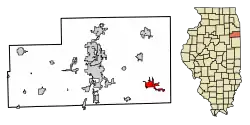Hopkins Park, Illinois | |
|---|---|
 Location of Hopkins Park in Kankakee County, Illinois | |
.svg.png.webp) Location of Illinois in the United States | |
| Coordinates: 41°04′11″N 87°37′05″W / 41.06972°N 87.61806°W[1] | |
| Country | United States |
| State | Illinois |
| County | Kankakee |
| Township | Pembroke |
| Area | |
| • Total | 4.14 sq mi (10.71 km2) |
| • Land | 4.14 sq mi (10.71 km2) |
| • Water | 0.00 sq mi (0.00 km2) |
| Elevation | 679 ft (207 m) |
| Population (2020) | |
| • Total | 597 |
| • Density | 144.31/sq mi (55.72/km2) |
| Time zone | UTC-6 (CST) |
| • Summer (DST) | UTC-5 (CDT) |
| ZIP code | 60944 |
| Area codes | 815 & 779 |
| FIPS code | 17-36190 |
| GNIS feature ID | 2398544[1] |
| Wikimedia Commons | Hopkins Park, Illinois |
| Website | www |
Hopkins Park is a village in Kankakee County, Illinois, United States. The population was 603 at the 2010 census,[3] down from 711 at the 2000 census. It is part of the Kankakee–Bradley Metropolitan Statistical Area.
Geography
Hopkins Park is located in southeastern Kankakee County. It is 15 miles (24 km) southeast of Kankakee, the county seat, and includes the former unincorporated community of Doney. Hopkins Park remains a rural, largely undeveloped community. Many of the roads are gravel, and a large portion of the population lives in an off-the-grid fashion. The town has very little to offer in terms of commerce and only recently did the area receive a gas pipeline. It has also been said that many of the residents, due to their off-the-grid lifestyle, were unable to be counted during the Census.
According to the 2010 census, Hopkins Park has a total area of 3.75 square miles (9.71 km2), all land.[4]
Hopkins Park is located on the Pembroke Savanna.[5]
Demographics
| Census | Pop. | Note | %± |
|---|---|---|---|
| 1980 | 673 | — | |
| 1990 | 601 | −10.7% | |
| 2000 | 711 | 18.3% | |
| 2010 | 603 | −15.2% | |
| 2020 | 597 | −1.0% | |
| U.S. Decennial Census[6] | |||
As of the census[7] of 2000, there were 711 people, 241 households, and 161 families residing in the village. The population density was 194.2 inhabitants per square mile (75.0/km2). There were 271 housing units at an average density of 74.0 per square mile (28.6/km2). The racial makeup of the village was 4.08% White, 92.26% African American, 0.14% Asian, 1.97% from other races, and 1.55% from two or more races. Hispanic or Latino of any race were 2.11% of the population.
There were 241 households, out of which 31.1% had children under the age of 18 living with them, 27.0% were married couples living together, 30.7% had a female householder with no husband present, and 32.8% were non-families. 26.6% of all households were made up of individuals, and 10.8% had someone living alone who was 65 years of age or older. The average household size was 2.95 and the average family size was 3.60.
In the village, the population was spread out, with 37.8% under the age of 18, 9.3% from 18 to 24, 22.8% from 25 to 44, 18.6% from 45 to 64, and 11.5% who were 65 years of age or older. The median age was 29 years. For every 100 females, there were 87.6 males. For every 100 females age 18 and over, there were 81.9 males.
The Median House Value was $62,300.[8]
The median income for a household in the village was $17,778, and the median income for a family was $19,792. Males had a median income of $33,125 versus $25,250 for females. The per capita income for the village was $8,788. About 35.4% of families and 44.2% of the population were below the poverty line, including 61.6% of those under age 18 and 30.1% of those age 65 or over.
References
- 1 2 3 U.S. Geological Survey Geographic Names Information System: Hopkins Park, Illinois
- ↑ "2020 U.S. Gazetteer Files". United States Census Bureau. Retrieved March 15, 2022.
- ↑ "Geographic Identifiers: 2010 Demographic Profile Data (G001): Hopkins Park village, Illinois". American Factfinder. U.S. Census Bureau. Retrieved February 15, 2019.
- ↑ "G001 - Geographic Identifiers - 2010 Census Summary File 1". United States Census Bureau. Archived from the original on February 13, 2020. Retrieved August 3, 2015.
- ↑ Moser, Whet. "The Ongoing Poverty of Pembroke, Illinois". Chicago magazine. Retrieved April 20, 2020.
- ↑ "Census of Population and Housing". Census.gov. Retrieved June 4, 2015.
- ↑ "U.S. Census website". United States Census Bureau. Retrieved January 31, 2008.
- ↑ "Search Results".